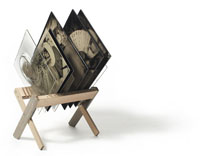What is Wet Plate Processing?
什麼是濕版攝影?

Wet Plate Processing is a photographic technique, utilizing physics and chemistry to preserve imagines. It was invented in mid 19th century England. (Reference to The Era of Wet-Plate Collodion Processing)
The goal is to preserve the image on a glass plate or coated metal sheet. In this process, the photographer first coats the plate with Collodion, then moves on to sensitize, expose, develop, fix, and finally rinse it. During these ten minutes or so, the glass plate remains wet. Hence the name “Wet Plate Processing” which is short for its full name “Wet Plate Collodion Processing”.
What makes “Wet Plate Processing” unique is its simplicity and ability to personalize. From the moment when the photographer decides to do the shooting, he/she has complete control over the entire process. For example, the size and ratio of the photograph, whether to make a positive or a negative image, type of lens to use, the chemical formulation, all of these are at the photographer’s disposal. There is no more worries about a certain photo supply being commercially available or problem with shortage. The chemical formulation and coating technique are unique to each photographer. At the final stage when the coating tears and fades, the color tone changed, the richness in gray scale, the chemicals causing streaks on the glass plate, and the bokeh….like oil painting…these are what make the process unique to others. That is what attracts people.
No one single plate of glass is perfect. A perfect plate would not be Wet Plate Processing. The likable imperfection. Within the decay and downtrodden, one finds images of life.
Neither are two plates of glass exactly alike. Each glass plate is a sole edition. When one truly knows how to appreciate Wet Plate Processing, one gets the feeling of “progress” by going back to the basics.

